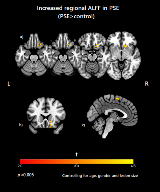Resting-State Functional Magnetic Resonance Metrics Differ Between Stroke Patients Who Did and Did Not Develop Post-stroke Epilepsy
Abstract number :
2.204
Submission category :
5. Neuro Imaging / 5B. Functional Imaging
Year :
2018
Submission ID :
502125
Source :
www.aesnet.org
Presentation date :
12/2/2018 4:04:48 PM
Published date :
Nov 5, 2018, 18:00 PM
Authors :
Georg K. Leonhardt, University College London; Luke Allen, University College London; Sjoerd B. Vos, Centre for Medical Image Computing, University College London; Epilepsy Society, Chalfont St Peter; Niraj Sharma, University College London; Britta Wandsc
Rationale: Post stroke epilepsy (PSE) affects 4% of stroke patients after 1 year and 8% after 5 years. As experimental strategies to disrupt epileptogenesis emerge, it is critical to find biomarkers of increased PSE risk, to examine enriched populations. We used amplitude of low frequency fluctuation (ALFF) and resting-state functional magnetic resonance imaging (rs-fMRI) to compare functional connectivity in patients with PSE (PSEP) with stroke patients without PSE (controls). Methods: Eight patients with ischemic strokes in the Middle Cerebral Artery (MCA) territory (4 female, age 44 – 56 y, five PSEP, three controls) identified from an existing stroke research database (Predicting Language Outcome and Recovery after Stroke – PLORAS) were analysed. Age was not different in the two groups (median 48y in PSE, 47 in controls). Epilepsy started between 6 and 12 months after the stroke. Results: Lesion size was not statistically different between the two groups. The ALFF was increased in the PSE group in the bilateral, midline SMA and in the contralesional (right) orbitofrontal cortex extending dorsally into the caudate head of the basal ganglia. ALFF was reduced in the ipsilesional (left) posterior hippocampus, posterior thalamus (pulvinar), and the contralesional (right) superior parietal lobule and mid- and posterior- insula (figure 1a,b). Conclusions: This is the first rs-fMRI study contrasting patients who developed PSE to those who did not, showing both increases and decreases in functional connectivity. Enhanced connectivity in PSEP in areas related to the sensorimotor system may reflect reorganisation as part of recovery following stroke. The caudate nucleus is part of the cortico-striato-thalamo-cortical loops, thought to have a remote influence on cortical oscillatory processes related to the control of epileptic seizures. Reductions in ALFF were seen in the contralesional mid- and posterior-insula and superior parietal lobule. These areas are part of the sensory-motor and the sensory and autonomic integrative system. Further decreases in the ipsilesional (i.e. left) hippocampus and posterior thalamus might reflect the putative epileptogenic nature of the loss of feed-forward inhibition between the thalamus and its neocortical connections. Separating adaptive changes following stroke from changes that may lead to increased risk of developing PSE will require further study with larger sample size. Funding: This work was supported by a Pilot Grant in Epilepsy from Epilepsy Research UK.

.tmb-.png?Culture=en&sfvrsn=39ce5c4_0)